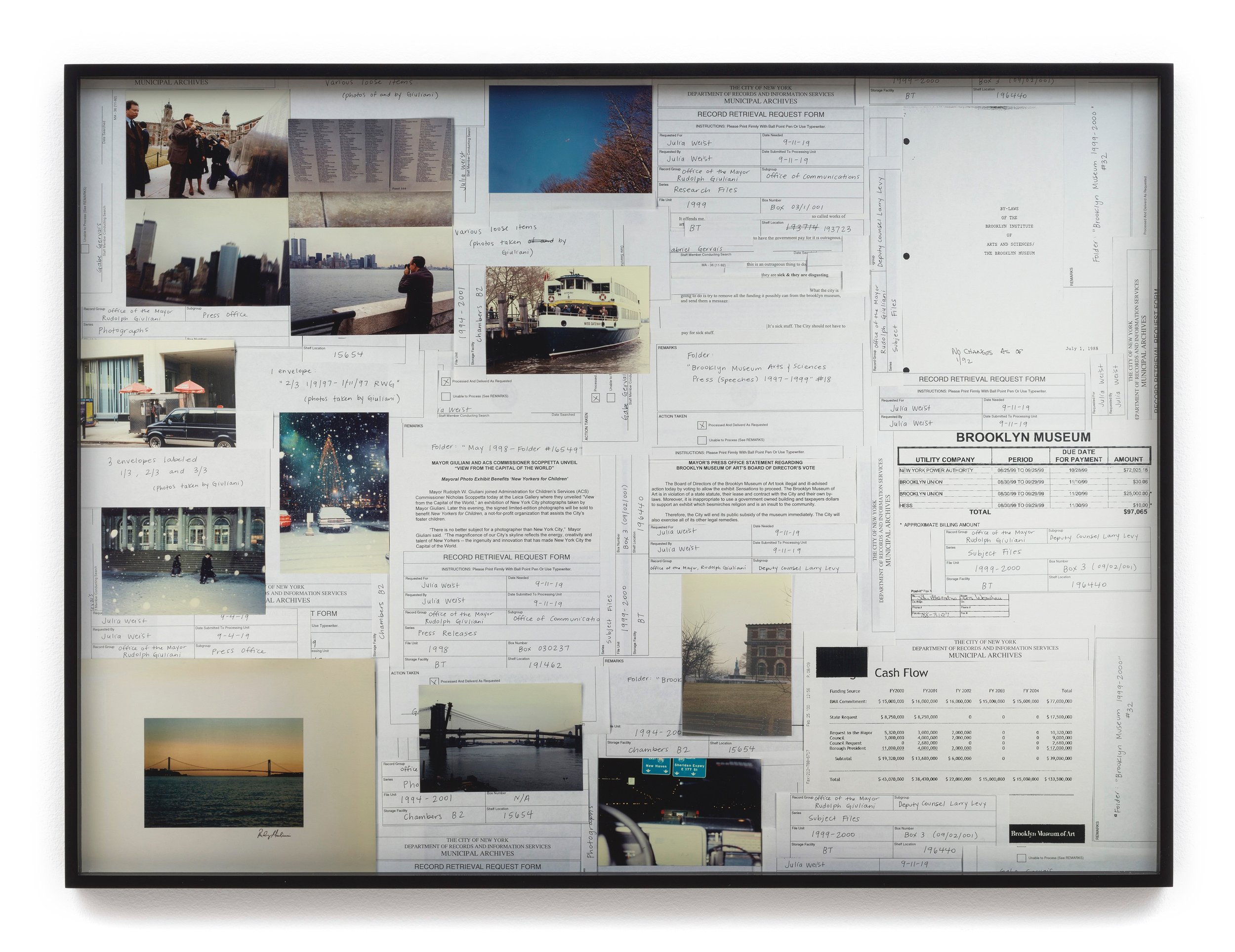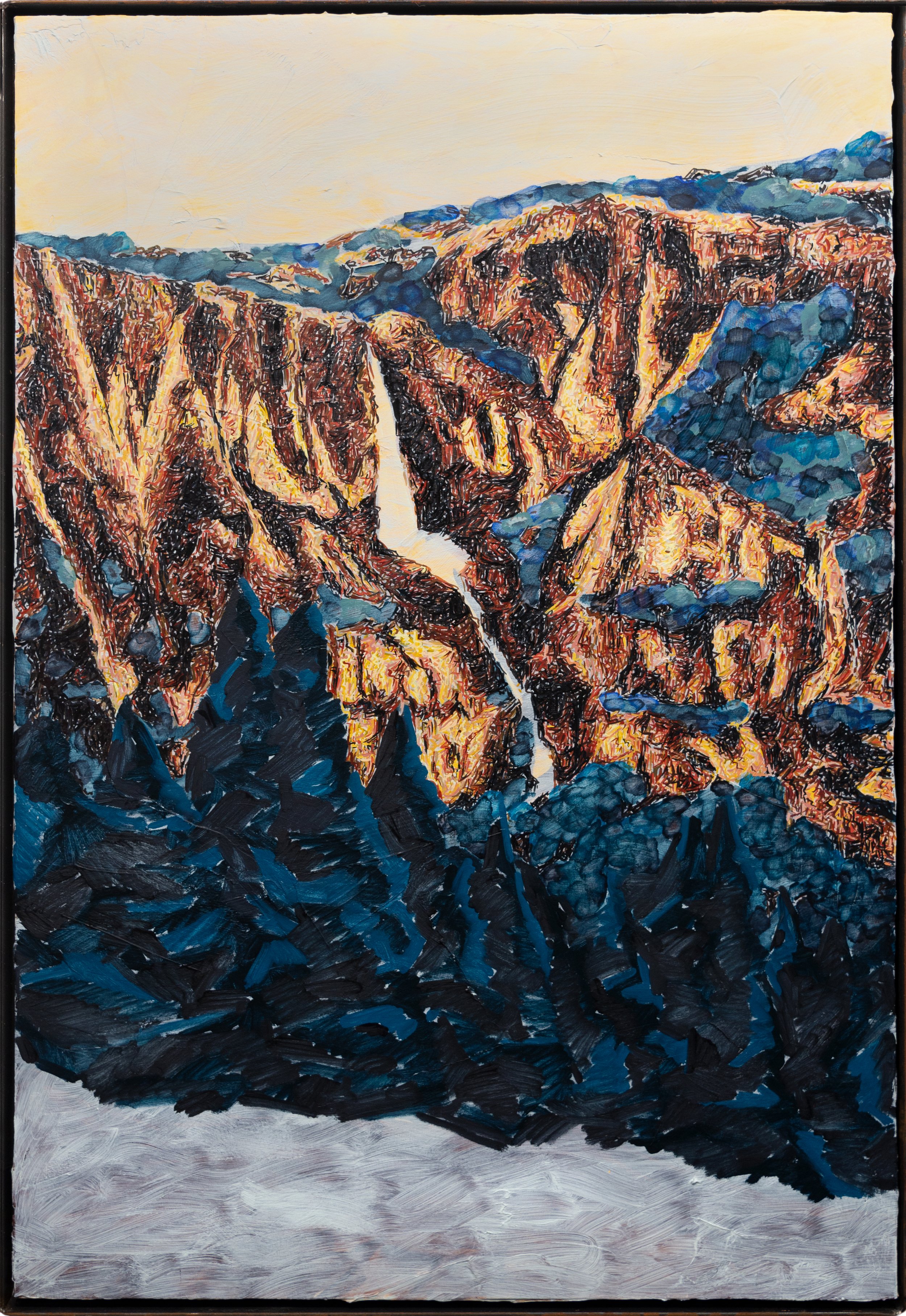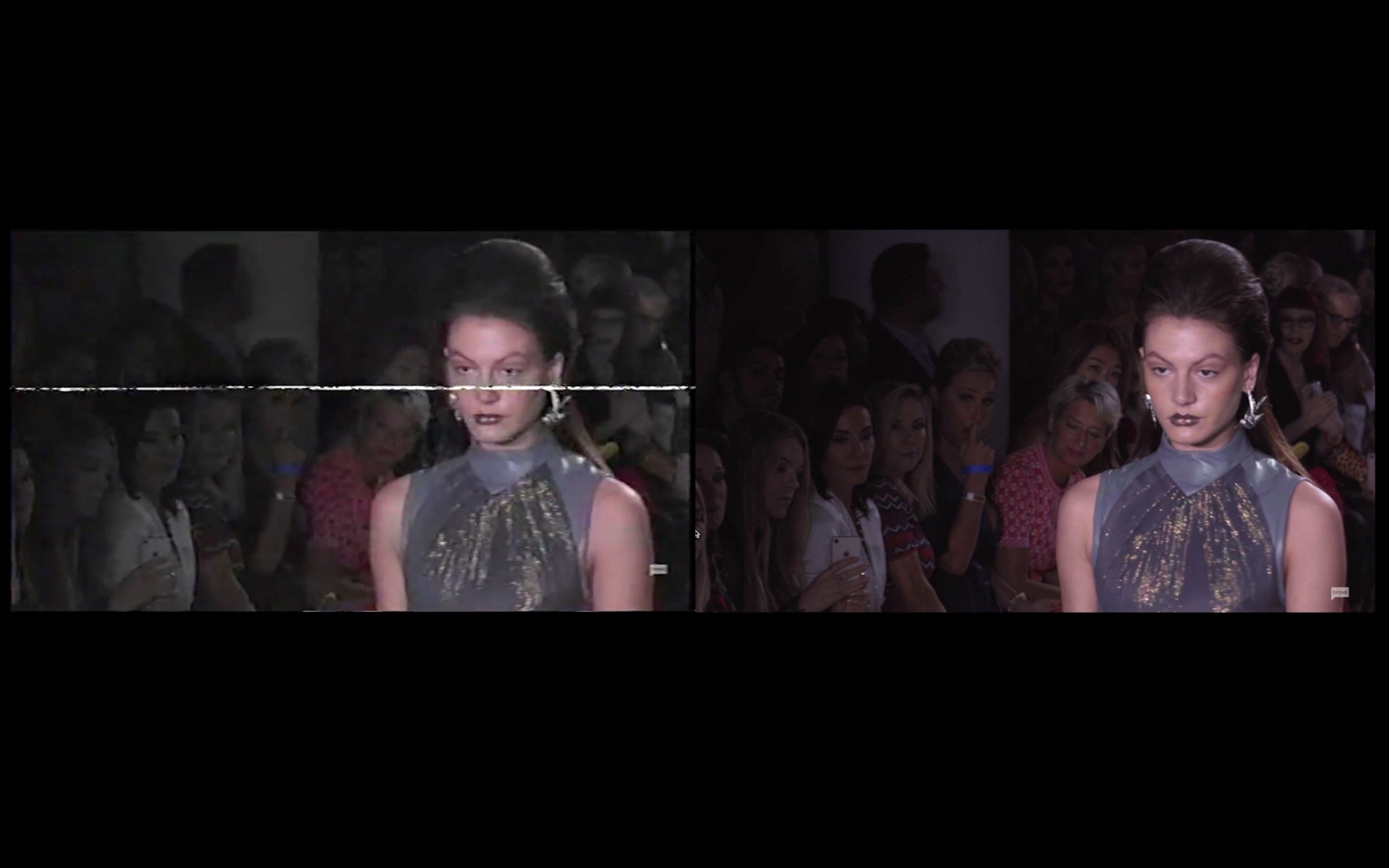Privacy Creep
organized by ernesto renda
November 12 - December 22, 2022
Opening Reception: November 12, 5-8pm
press release
Moskowitz Bayse is pleased to present Privacy Creep, an exhibition organized by Ernesto Renda with works by Luke Francis Austin, Rubén Esparza, Kate Klingbeil, Ernesto Renda, Ivan Rios-Fetchko, Jacob Sorkin, and Julia Weist. The exhibition will be on view in the gallery’s viewing room from November 12 - December 22, 2022. We will host an opening reception at the gallery on November 12 from 5-8pm.
This summer, The New York Times published a troubling, but all-too-familiar story about the Great Salt Lake in Utah. Environmental scientists have observed the Lake’s drying and shrinking for some time, but with the imminent risk of massive ecological disruption as well as the release of poisonous arsenic from the lake bed into the air, the community is “at the precipice. And it’s terrifying”. A major cause of these terrifying conditions? A boom in population growth and water usage around the lake. I think I was ten or eleven when my grandfather taught me about the tragedy of the commons. We had put out a bowl of cherries on the table after lunch, and, while my grandfather was engrossed in conversation, the cherries were gobbled up; my grandfather used it as an opportunity to teach us an ethical lesson. The tragedy of the commons plays out as individuals appropriate shared resources for private gain and without consideration of the diminishing resource as a whole. We might think of the commons as an alternative to the personal and the private, categorical orders that increasingly shape our material and political lives. The question I’ve asked while putting this show together: where do we locate or evaluate the artistic practice of taking and making from the commons in this tragedy? One tragic reversal we see so often is that what is good for some art, is bad for the commons; what is bad for some Art, is good for the Public. Expanding our perspective beyond this binary of tragic give and take, the artists in Privacy Creep draw attention to public spaces, common materials, and shared thought.
Ivan Ríos-Fetchko began collecting tourist slides as reference images for paintings after he observed the visitors at a national park line up to take almost the exact same image, one after the other. Struck by the grandeur of natural beauty too glorious to be on private land, each visitor feels the need to apprehend a piece of it, as they cannot take the waterfall home with them.
While Ríos-Fetchko’s park visitors take an image of the park in lieu of the real thing, Kate Klingbeil quite literally collects bits and pieces of the park and includes them in her work, imbuing these overlooked objects with new meaning and value. Scouring various estuaries of North America, Klingbeil has amassed an expansive collection of rocks, driftwood, shells, and human detritus. She then pulls from this collection to create her three-dimensional paintings of anthropomorphized roots and stems. Klingbeil observes the “desire paths” in her landscapes. Being the most direct way to get from one place to another, these unsanctioned “ways” become unofficial “paths”, their ruts and grooves growing deeper each time something travels across them.
Rubén Esparza began photographing Los Angeles’ former (and current) cruising sites in 2007 and continues to develop his Ghosted series today. Rather than the iconic views in Rîos-Fetchko’s paintings, Esparza’s works in Privacy Creep focus matter-of-factly on Elysian Park near the city’s downtown (ancestral home of the Tongva and Chumash peoples). Absent the explicit scenes of gay sex, they simply document the park’s natural ambiance, leaving the viewer to ponder the acts that have taken place in these groves. Esparza finishes the works with marks of his ejaculation on the prints as a form of sacrament or acclamation. These captured images draw out an irony that has defined the lives of sexual minorities in repressive societies, where private and personal pleasures find a safe place in the unterritorialized “public” space of the commons. Esparza points out the recent presence of frisbee golf targets, a measured sign of the gentrification and de-cruisifying of the park’s groves in these mostly Latinx cruising grounds.
The anonymity of cruising culture is mirrored in the work of Luke Francis Austin, who finds poetic moments in fetish porn they find online. In their painting, Two Close, the artist closes in on a sublime moment of intimate contact between bodies in latex suits. In our studio visits, Luke reflects on the transformation that the subjects of the porn videos undergo, embodying roles that move beyond their own off-camera identities. Further, the uploads of porn videos are often the latest in a long chain of custody from their makers, often masking the original intent and confusing the sense of ownership over the performers’ bodies.
Both image and the written word allow us to smuggle our presence and consciousness across spatio-temporal borders to reach people we will never meet. Jacob Sorkin’s paintings explore the pre-verbal or algorithmic interpretation of written characters, the gestalt of a page of text before contextual meaning can paper over it. He cites psychoanalytic thought, AI (as collective consciousness) and the visuality of experimental poems as influences for his paintings. The process of making and exhibiting abstractions involves the ultimate forfeit of specific communication that representation offers. Untitled (2022) evokes the anxiety of the subject’s induction into a linguistic and contested consciousness, while extending the hope for abstraction to accurately communicate a feeling in a pre-verbal register.
Tape 1 (Real Housewives of New York), on view in the public bathroom at Moskowitz Bayse, contains a copied scene from the reality tv show where I appear in the background at a fashion show. Those particular shots have been degraded through excessive playback and physically manipulating the tape. This inquiry into video as a plastic medium began when I heard of a phenomenon lost to the era of VHS and rental tapes. Images would often become fuzzy and chewed up during scenes that had been re-played more than the rest of the tape. Often these would be scenes with sex or nudity, and therefore, in its deterioration, the tape as a shared object would begin to tell a story about the person or community who had been consuming it. We often hear about the loss of our ability to copy content when we switched over to digital formats, but it would seem we also lost something of the tape’s potential to read its user, to document and reveal their libidinal investments. The duplication of digital media is seemingly endless and lossless, and is therefore increasingly privatized, encrypted in seemingly infinite cyberspace. In this paradigm, it is the inaccessible software which knows our every move, how many times we have watched something, whether we skipped to a certain part or replayed another part—data that can be transformed into capital. In our rapid transition to streaming, we become ever more inextricably bound to the private interests that tell and give us access to our stories, relating to media as a subscription service (one that watches us) where previously it was modeled on the library.
In 2019, Julia Weist was named Public Artist in Residence in the New York City Department of Records and Information Services, a residency program that sprang from Mierle Laderman Ukeles work with the Department of Sanitation that began in the 1970s. The works in Weist's Public Record series were made with material found in the department’s vast archive of documents and were created according to a bureaucratic process that ensured the works themselves would become official municipal records. The New York City government is now legally required to support the digital availability of the images in high-resolution format alongside Weist's physical prints in the publicly-accessible Municipal Archives. In Giuliani, we see collected evidence of the former mayor’s largely unacknowledged amateur photography career. Weist’s work was produced in completely public conditions, with public equipment and public source material. As a result, the works in their final form are commensurately public objects.
Looking at these works, I can intuit the public activity of the artists’ taking and making with the commons. The works, perhaps before offering mandates of civic responsibility, gently remind me of the other people and things with whom my desires overlap. I’m never looking quite by myself.
Text by Ernesto Renda
Luke Austin is a Brooklyn-based artist who works with painting, drawing and photography. Born in Orange County, CA, Luke went on to study at Cal Poly San Luis Obispo, graduating in 2020 with a BFA in Studio Art. Since leaving school and moving to New York, Luke’s work has been presented alongside numerous artists, most notably with Anonymous Gallery and in the Brooklyn Museum through the Black Art Sessions facilitated by Eboni Haynes and hosted by Cassandra Press.
Rubén Esparza is a multidisciplinary artist and independent curator, using the insight of both roles to synergize intensely cross-referential physical and temporary works of art and exhibitions. Exploring Queer and Latinx histories, existential trauma, and the reconciliation of his heritage that of the colonizer and the colonized, Esparza uses analog materials alongside complex experimental digital-driven works to create sociopolitical commentary or homage to brownness and or queerness. Esparza is the founder and director of the Queer Biennial (Los Angeles).
Kate Klingbeil (b. 1990) is a visual artist working in painting, sculpture and film. She has presented solo exhibitions at Steve Turner, Los Angeles (Unseen Animal, 2022 & Grown Woman, 2021); SPRING/BREAK, New York with Field Projects (Burrowed, 2020); and a two-person show with Rebecca Ness at Monya Rowe, New York (On The Inside, 2019). Kate has been included in group exhibitions at Nino Mier, Los Angeles (2021); Steve Turner, Los Angeles (2020); Nevven Gallery, Gothenburg (2019); Andrew Edlin, New York (2019); Paul Kasmin, New York (2018), The Hole, New York (2022 & 2018), and Andrew Rafacz, Chicago (2017). She has attended residencies at Silver Art Projects, (NYC, 2021), Oak Spring Garden Foundation (VA, 2021), Marble House Projects (VT, 2021), the Arts/Industries program at John Michael Kohler Art Center (WI, 2020), Yaddo (NY, 2019), ACRE (WI, 2016) and Kala Art Institute (CA, 2012). Her work has been written about in publications including the New York Times (2020), Artnet (2020) and Maake Magazine (2019). Kate received a BFA in Printmaking from California College of the Arts in Oakland, CA in 2012.
Ivan Ríos-Fetchko (b.1994, Los Angeles, CA) lives and works in Los Angeles. He attended the Brown/Risd Dual-Degree program, earning a BFA in Painting and a BA in Comparative Literature. His work has been shown at De Boer Gallery, The Lodge, Tilton Gallery and, most recently, in a solo presentation with Tyler Park Presents.
Jacob Sorkin (b. 1995, New York) is an artist and writer based in upstate New York and New Mexico. He studied Painting at Rhode Island School of Design and graduated from Deep Springs College in 2017. He presented a solo exhibition of work in a Chashama Space to Present in 2013 (New York, NY) and his work has been exhibited in group exhibitions at Zürcher Gallery (New York, NY), Real Pain / Harkawik (Los Angeles, CA) and Five Car Garage / Emma Gray HQ (Los Angeles, CA).
Julia Weist is a visual artist based in New York. Her work is in the permanent collections of The Museum of Modern Art, The Metropolitan Museum of Art, The Brooklyn Museum, The Art Institute of Chicago, The Los Angeles County Museum of Art and The MIT List Visual Art Center among many other collections. In 2019 Weist was the recipient of a public art commission from the NYC Department of Cultural Affairs and an inaugural commission from The Shed. Her work has recently been exhibited at The Queens Museum, The Gwangju Biennale, The Hong-Gah Museum (Taiwan), nGbK (Berlin), Kunstinstituut Melly (Rotterdam) and her most recent solo exhibition was with Rachel Uffner Gallery in 2022.
Ernesto Renda (b. 1995, New Jersey) is an artist and curator based in New York. In 2018, he completed his BFA in Painting from Rhode Island School of Design and his BA in Modern Culture and Media Studies from Brown University. Solo and two person exhibitions include a forthcoming booth at NADA Miami ( November 30 - December 3, 2022) with Moskowitz Bayse, Grove Collective (London, 2022), In Lieu Gallery (Los Angeles, 2022), Moskowitz Bayse (Los Angeles, 2020), Empty Circle Space (NYC, 2020), The National Arts Club (NYC, 2020), among others. He has participated in group exhibitions at Tilton Gallery (NYC), James Fuentes (NYC), Grove Collective (London), 1969 Gallery (NYC), Moskowitz Bayse (Los Angeles), Field Projects (NYC), Shin Gallery (NYC), RegularNormal (NYC), Georgetown College (Kentucky), Bell Gallery at Brown University (RI) among others. He has curated exhibitions at Moskowitz Bayse, Zürcher Gallery (NYC) and Below Grand Gallery (f.k.a. Super Dutchess, NYC). His work has been featured in Artnet News, Two Coats of Paint, Hypebeast and Gayletter among others. In 2021 he was awarded the Silver Art Projects studio residency.




